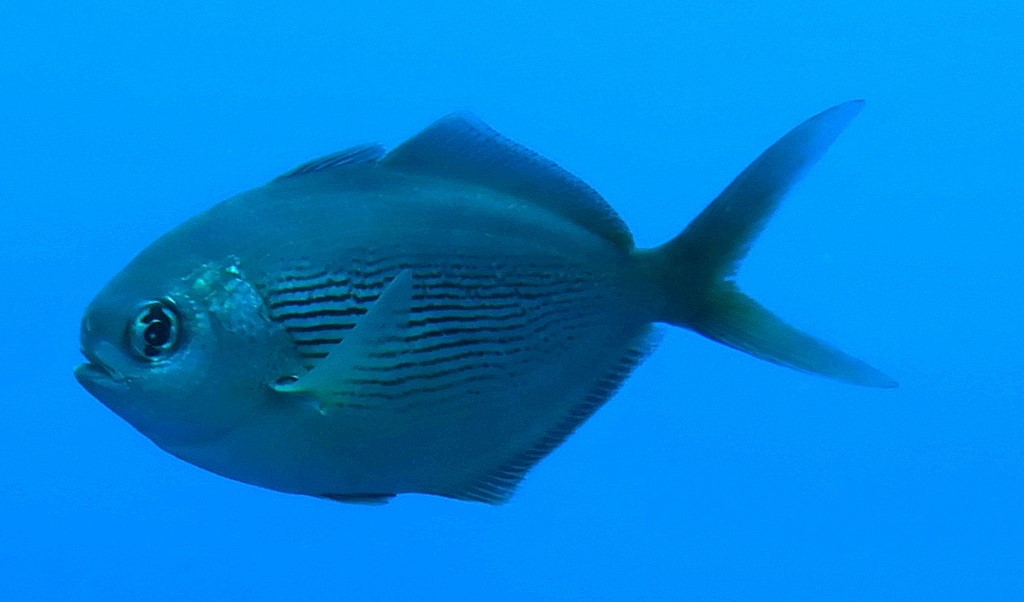PSENES CYANOPHRYS - (VALENCIENNES, 1833)
Picture courtesy of: Alain Daoulas
Actinopterygii (Gigaclass) > Actinopteri (Class) > Teleostei (Subclass) > Scombriformes (Order) > Stromateoidei (Suborder) > Nomeidae (Family) > Psenes (Genus)
Psenes aux sourcils bleus, Freckled driftfish, Blue eyebrow-fish, Blue driftfish, Derivante rayado, Pastorcillo amarillento, Rombudo, Gevlekte dryfvis, Suji-hanabira-uo, スジハナビラウオ, 玻璃玉鲳,
Synonymes
Cubiceps multiradiatus (Günther, 1872)
Parapsenes rotundus (Smith, 1949)
Psenes auratus (Valenciennes, 1833)
Psenes chapmani (Fowler, 1906)
Psenes cyanophris (Valenciennes, 1833)
Psenes fuscus (Guichenot, 1866)
Psenes guamensis (Valenciennes, 1833)
Psenes javanicus (Valenciennes, 1833)
Psenes kamoharai (Abe, Kojima & Kosakai, 1963)
Psenes leucurus (Valenciennes, 1833)
Psenes pacificus (Meek & Hildebrand, 1925)
Psenes rotundus (Smith, 1949)
Psennes cyanophrys (Valenciennes, 1833)
----------------------
Description
Dorsal spines (total): 9-12; Dorsal soft rays (total): 23-28; Anal spines: 3; Anal soft rays: 22-28; Pectoral fins rays: 17-20. Lateral line scales: 60-70; Vertebrae: 31. Body firm, deep and strongly compressed. Head long: 28-42% SL, body depth 42-56% SL, predorsal length 34–38%, preanal length: 50-56% SL, and pectoral fin length 32-37% SL. Snout length: 24-37% HL, eye diameter: 22-28% HL, and upper jaw: 29-34% HL. Vertebrae: 12-13 + 18-19 = 31. Predorsal scales extending forward to nostrils; Scales very small in anterior patch, sharply demarcated from larger posterior scales; Scales on top of head not reaching as far as front edge of eyes; Scales between lateral line and dorsal fin origin: 6-8; Scales between lateral line and ventral midline: 22-27. Rounded snout; Terminal jaw; Small teeth, conical, mostly uniserial; Teeth on tongue and vomer minute, palatine teeth larger. Branchiostegal rays: 6; Gill rakers: 7-8/17-21. Deeply forked caudal fin with rounded lobes. Max. length: 23.0 cm SL. Depth range: 20 - 550 m.
Color
Early juveniles silvery yellow, with numerous black stripes; Metamorphosed juveniles through adults yellowish brown dorsally, dark purplish brown to black ventrally, or uniformly dark purplish with lateral line in pale band, and pectoral fins grey.
Etymology
Psenes: from Greek, psenos, -e, -on = without hair. Reffering to their palate which is smooth and without any teeth. A characteristics of this species.
cyanophrys: from Greek, kyanos = dark blue-green in color + from ancient Greek, ophrûs = eyebrow. Referring to bluish streak above each eye on some specimens.
Original description: Psenes cyanophrys Valenciennes, 1833 - Type locality: New Ireland, Bismarck Archipelago, Papua New Guinea, western Pacific.
Distribution
Circumglobal in tropical through warm temperate seas (including southern Sea of Japan).
Biology
Inhabits the open ocean. Found under floating weeds or debris. Adults were found under large weed-rafts, using the shade as cover. They also form schools. Associated with Sargassum and jellyfish. Feeds mostly on planktonic organisms including copepods, amphipods, fish eggs and larvae, and chaetognaths. Nektonic
Actinopterygii (Gigaclass) > Actinopteri (Class) > Teleostei (Subclass) > Scombriformes (Order) > Stromateoidei (Suborder) > Nomeidae (Family) > Psenes (Genus)
Psenes aux sourcils bleus, Freckled driftfish, Blue eyebrow-fish, Blue driftfish, Derivante rayado, Pastorcillo amarillento, Rombudo, Gevlekte dryfvis, Suji-hanabira-uo, スジハナビラウオ, 玻璃玉鲳,
Synonymes
Cubiceps multiradiatus (Günther, 1872)
Parapsenes rotundus (Smith, 1949)
Psenes auratus (Valenciennes, 1833)
Psenes chapmani (Fowler, 1906)
Psenes cyanophris (Valenciennes, 1833)
Psenes fuscus (Guichenot, 1866)
Psenes guamensis (Valenciennes, 1833)
Psenes javanicus (Valenciennes, 1833)
Psenes kamoharai (Abe, Kojima & Kosakai, 1963)
Psenes leucurus (Valenciennes, 1833)
Psenes pacificus (Meek & Hildebrand, 1925)
Psenes rotundus (Smith, 1949)
Psennes cyanophrys (Valenciennes, 1833)
----------------------
Description
Dorsal spines (total): 9-12; Dorsal soft rays (total): 23-28; Anal spines: 3; Anal soft rays: 22-28; Pectoral fins rays: 17-20. Lateral line scales: 60-70; Vertebrae: 31. Body firm, deep and strongly compressed. Head long: 28-42% SL, body depth 42-56% SL, predorsal length 34–38%, preanal length: 50-56% SL, and pectoral fin length 32-37% SL. Snout length: 24-37% HL, eye diameter: 22-28% HL, and upper jaw: 29-34% HL. Vertebrae: 12-13 + 18-19 = 31. Predorsal scales extending forward to nostrils; Scales very small in anterior patch, sharply demarcated from larger posterior scales; Scales on top of head not reaching as far as front edge of eyes; Scales between lateral line and dorsal fin origin: 6-8; Scales between lateral line and ventral midline: 22-27. Rounded snout; Terminal jaw; Small teeth, conical, mostly uniserial; Teeth on tongue and vomer minute, palatine teeth larger. Branchiostegal rays: 6; Gill rakers: 7-8/17-21. Deeply forked caudal fin with rounded lobes. Max. length: 23.0 cm SL. Depth range: 20 - 550 m.
Color
Early juveniles silvery yellow, with numerous black stripes; Metamorphosed juveniles through adults yellowish brown dorsally, dark purplish brown to black ventrally, or uniformly dark purplish with lateral line in pale band, and pectoral fins grey.
Etymology
Psenes: from Greek, psenos, -e, -on = without hair. Reffering to their palate which is smooth and without any teeth. A characteristics of this species.
cyanophrys: from Greek, kyanos = dark blue-green in color + from ancient Greek, ophrûs = eyebrow. Referring to bluish streak above each eye on some specimens.
Original description: Psenes cyanophrys Valenciennes, 1833 - Type locality: New Ireland, Bismarck Archipelago, Papua New Guinea, western Pacific.
Distribution
Circumglobal in tropical through warm temperate seas (including southern Sea of Japan).
Biology
Inhabits the open ocean. Found under floating weeds or debris. Adults were found under large weed-rafts, using the shade as cover. They also form schools. Associated with Sargassum and jellyfish. Feeds mostly on planktonic organisms including copepods, amphipods, fish eggs and larvae, and chaetognaths. Nektonic
Last update: 6, June 2024
